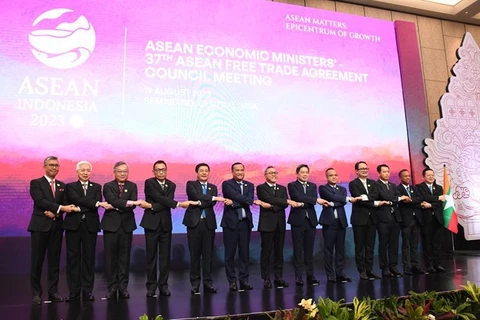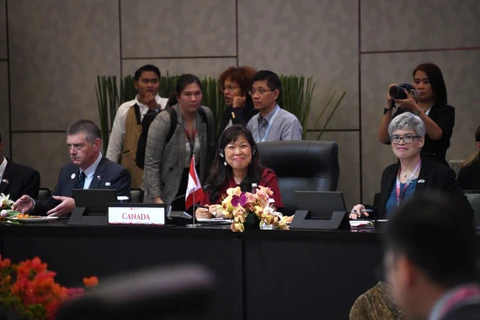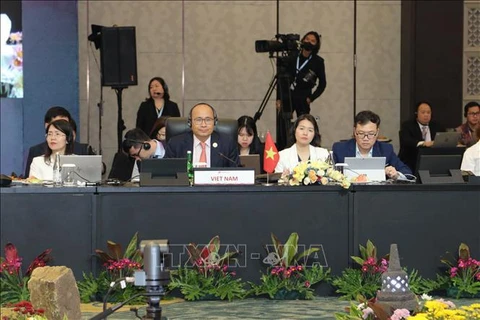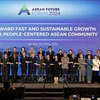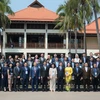Jakarta (VNA) – Consultations between the ASEAN Economic Ministers (AEM) and Chinese and Indian partners took place in Semarang, Indonesia, on August 21, as part of the ongoing 55th AEM Meeting.
The 22nd AEM – Ministry of Commerce (MOFCOM) of the People's Republic of China Consultation was co-chaired by Indonesian Minister of Trade Zulkifli Hasan and Chinese Vice Minister of Commerce Li Fei. It welcomed China’s continued support for the region’s post-pandemic recovery, particularly in strengthening the regional health capacities, maintaining trade and market openness, as well as safeguarding food security.
The meeting reiterated the commitment to implement the ASEAN-China Joint Statement on Cooperation in Support of the ASEAN Comprehensive Recovery Framework (ACRF) and the ASEAN-China Economic Ministers’ Joint Statement on Combating the Coronavirus Disease (COVID-19) and Enhancing ACFTA Cooperation. The sides also reaffirmed their commitment to fully and effectively implement agreements under the ASEAN – China Free Trade Area (ACFTA), including the Upgrading Protocol of the ACFTA.
The 22nd AEM – Ministry of Commerce (MOFCOM) of the People's Republic of China Consultation was co-chaired by Indonesian Minister of Trade Zulkifli Hasan and Chinese Vice Minister of Commerce Li Fei. It welcomed China’s continued support for the region’s post-pandemic recovery, particularly in strengthening the regional health capacities, maintaining trade and market openness, as well as safeguarding food security.
The meeting reiterated the commitment to implement the ASEAN-China Joint Statement on Cooperation in Support of the ASEAN Comprehensive Recovery Framework (ACRF) and the ASEAN-China Economic Ministers’ Joint Statement on Combating the Coronavirus Disease (COVID-19) and Enhancing ACFTA Cooperation. The sides also reaffirmed their commitment to fully and effectively implement agreements under the ASEAN – China Free Trade Area (ACFTA), including the Upgrading Protocol of the ACFTA.
The meeting adopted the ASEAN-China Initiative on Enhancing Cooperation on E-Commerce, which seeks to promote closer enterprise cooperation, jointly carry out capacity-building activities, and promote cross-border e-commerce.
It welcomed MOFCOM’s proposal on jointly carrying out ASEAN-China Exchanges on Laws and Regulations related to Trade and Economic Cooperation, which could further implement the important consensus reached by the sides’ leaders in the field. The meeting also noted the importance of regional and sub-regional cooperation such as BIMP EAGA-China Cooperation (BECC) and Lancang-Mekong Cooperation (LMC) to bridge the development gaps among the AMS and to build a stronger ASEAN community, among other matters.
According to ASEAN Statistics, total merchandise trade between ASEAN and China reached 722 billion USD in 2022, registering an increase of 7.8% year-on-year. China maintained its position as ASEAN’s largest trading partner since 2009 and the bloc was China's largest trading partner for three consecutive years since 2020.
On the same day, the 20th AEM-India Consultation (AEM-India Consultation) – co-chaired by Hasan and Ajesh Agrawal, Additional Secretary at the Indian Ministry of Commerce and Industry’s Department of Commerce – emphasised that to navigate the challenging global environment, an inclusive, stronger and more impactful cooperation between ASEAN and India is essential. The meeting tasked officials to explore ways to embed practical activities of mutual interest that will mitigate the effects of these global challenges on the ASEAN-India economic relationship, especially in the areas of sustainable development, digital transformation, and supply chain resilience.
It welcomed the progress of the Review of the ASEAN-India Trade in Goods Agreement (AITIGA) and endorsed the Term of Reference of the AITIGA Joint Committee, the Work Plan of the AITIGA Review Negotiations, and the Negotiating Structure for the AITIGA Review.
The meeting was held in support of India’s G20 Presidency under the theme “One Earth. One Family. One Future”, and took note of the activities undertaken by the ASEAN-India Business Council (AIBC) in 2023, including the 5th ASEAN-India Business Summit. It encouraged the AIBC to continue its initiatives in promoting and enhancing economic, trade and investment linkages between the bloc and India to ensure the continuity of business opportunities with all their trading partners and to strengthen the regional supply chain.
In 2022, based on preliminary ASEAN statistics, two-way trade between ASEAN and India reached 113 billion USD, increasing by 23.4% year-on-year, while total foreign direct investment (FDI) inflows from India hit 681 million USD./.
VNA

